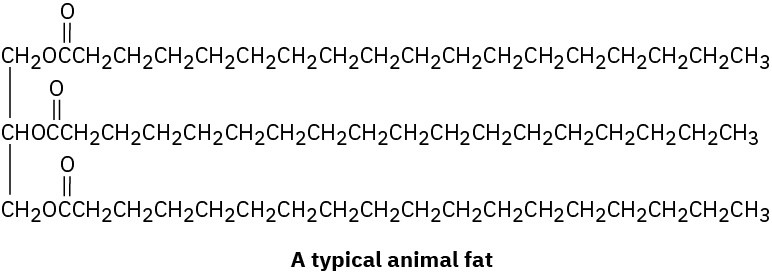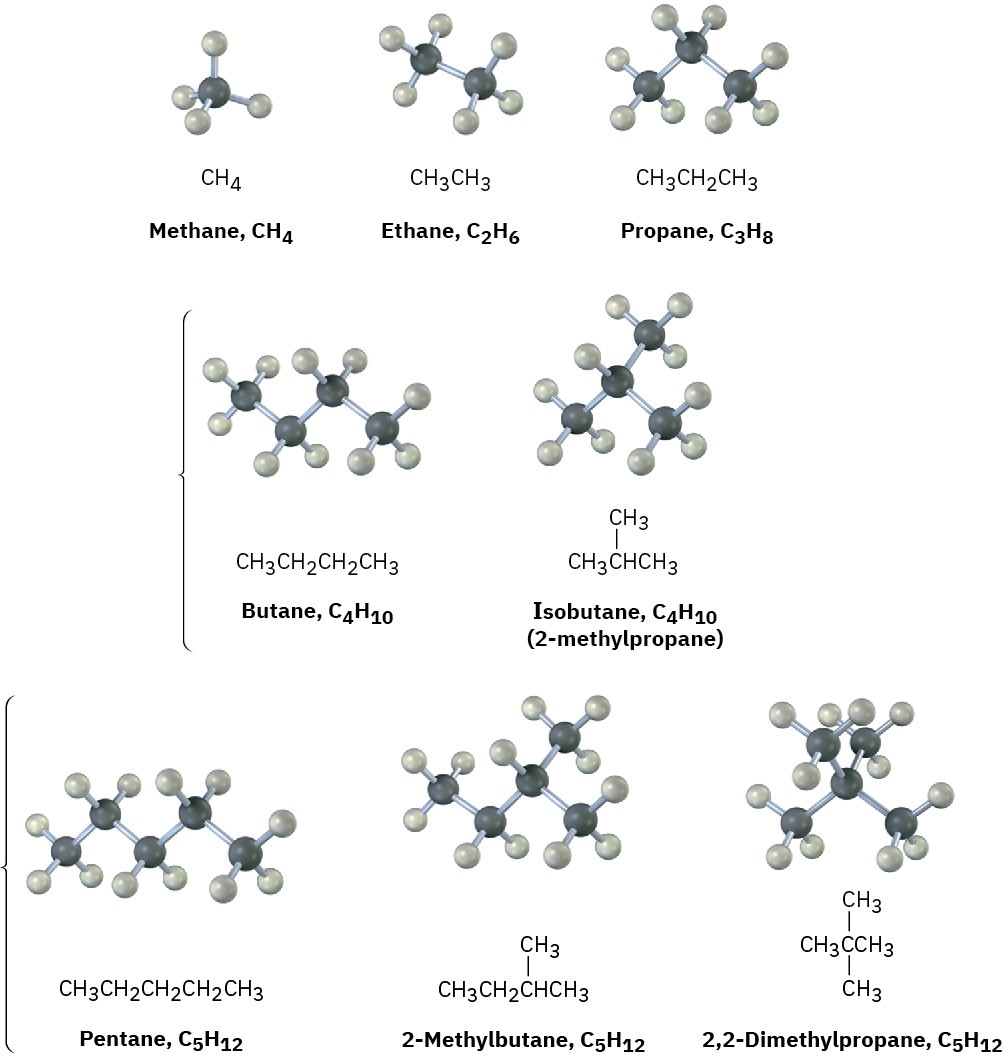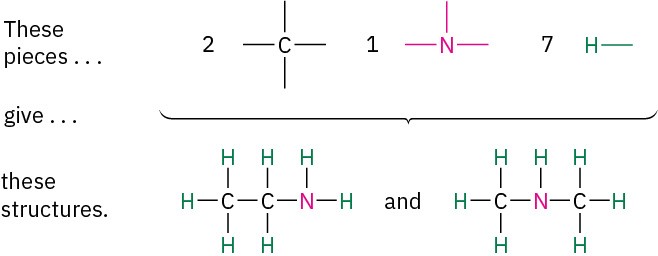3.2 Alkanes and Alkane Isomers
Before beginning a systematic study of the different functional groups, let’s look first at the simplest family of molecules to develop some general ideas that apply to all families. We saw in Section 1.7 that the carbon–carbon single bond in ethane results from σ (head-on) overlap of carbon sp3 hybrid orbitals. If we imagine joining three, four, five, or even more carbon atoms by C–C single bonds, we can generate the large family of molecules called alkanes.

Alkanes are often described as saturated hydrocarbons: hydrocarbons because they contain only carbon and hydrogen; saturated because they have only C–C and C–H single bonds and thus contain the maximum possible number of hydrogens per carbon. They have the general formula CnH2n+2, where n is an integer. Alkanes are also occasionally called aliphatic compounds, a name derived from the Greek aleiphas, meaning “fat.” We’ll see in Section
27.1 that many animal fats contain long carbon chains similar to alkanes.

Think about the ways that carbon and hydrogen might combine to make alkanes. With one carbon and four hydrogens, only one structure is possible: methane, CH4. Similarly, there is only one combination of two carbons with six hydrogens (ethane, CH3CH3) and only one combination of three carbons with eight hydrogens (propane, CH3CH2CH3). When larger numbers of carbons and hydrogens combine, however, more than one structure is possible. For example, there are two substances with the formula C4H10: the four carbons can all be in a row (butane), or they can branch (isobutane). Similarly, there are three C5H12 molecules, and so on for larger alkanes.

Compounds like butane and pentane, whose carbons are all connected in a row, are called straight-chain alkanes, or normal alkanes. Compounds like 2-methylpropane (isobutane), 2- methylbutane, and 2,2-dimethylpropane, whose carbon chains branch, are called branched- chain alkanes.
Compounds like the two C4H10 molecules and the three C5H12 molecules, which have the same formula but different structures, are called Isomers, from the Greek isos + meros, meaning “made of the same parts.” Isomers have the same numbers and kinds of atoms but differ in the way the atoms are arranged. Compounds like butane and isobutane, whose atoms are connected differently, are called constitutional isomers. We’ll see shortly that other kinds of isomers are also possible, even among compounds whose atoms are connected in the same order. As Table 3.2 shows, the number of possible alkane isomers increases dramatically with the number of carbon atoms.
Table 3.2 Number of Alkane Isomers
|
Formula |
Number of isomers |
Formula |
Number of isomers |
|
C6H14 |
5 |
C10H22 |
75 |
|
Number of isomers |
Formula |
Number of isomers |
|
|
C7H16 |
9 |
C15H32 |
4347 |
|
C8H18 |
18 |
C20H42 |
366,319 |
|
C9H20 |
35 |
C30H62 |
4,111,846,763 |
Constitutional isomerism is not limited to alkanes—it occurs widely throughout organic chemistry. Constitutional isomers may have different carbon skeletons (as in isobutane and butane), different functional groups (as in ethanol and dimethyl ether), or different locations of a functional group along the chain (as in isopropylamine and propylamine).
Regardless of the reason for the isomerism, constitutional isomers are always different compounds with different properties but with the same formula.

A given alkane can be drawn in many ways. For example, the straight-chain, four-carbon alkane called butane can be represented by any of the structures shown in Figure 3.3.
These structures don’t imply any particular three-dimensional geometry for butane; they indicate only the connections among atoms. In practice, as noted in Section 1.12, chemists rarely draw all the bonds in a molecule and usually refer to butane by the condensed structure, CH3CH2CH2CH3 or CH3(CH2)2CH3. Still more simply, butane can be represented as n-C4H10, where n denotes normal (straight-chain) butane.

Figure 3.3 Some representations of butane, C4H10. The molecule is the same regardless of how it’s drawn. These structures imply only that butane has a continuous chain of four carbon atoms; they do not imply any specific geometry.
Straight-chain alkanes are named according to the number of carbon atoms they contain, as shown in Table 3.3. With the exception of the first four compounds—methane, ethane, propane, and butane—whose names have historical roots, the alkanes are named based on
Greek numbers. The suffix –ane is added to the end of each name to indicate that the molecule identified is an alkane. Thus, pentane is the five-carbon alkane, hexane is the six- carbon alkane, and so on. We’ll soon see that these alkane names form the basis for naming all other organic compounds, so at least the first ten should be memorized.
Table 3.3 Names of Straight-Chain Alkanes
|
Name |
Formula (CnH2n+2) |
Number of carbons (n) |
Name |
Formula (CnH2n+2) |
|
|
1 |
Methane |
CH4 |
9 |
Nonane |
C9H20 |
|
2 |
Ethane |
C2H6 |
10 |
Decane |
C10H22 |
|
3 |
Propane |
C3H8 |
11 |
Undecane |
C11H24 |
|
4 |
Butane |
C4H10 |
12 |
Dodecane |
C12H26 |
|
5 |
Pentane |
C5H12 |
13 |
Tridecane |
C13H28 |
|
6 |
Hexane |
C6H14 |
20 |
Icosane |
C20H42 |
|
7 |
Heptane |
C7H16 |
30 |
Triacontane |
C30H62 |
|
8 |
Octane |
C8H18 |
|
|
|
Worked Example 3.1Drawing the Structures of IsomersPropose structures for two isomers with the formula C2H7N.StrategyWe know that carbon forms four bonds, nitrogen forms three, and hydrogen forms one. Write down the carbon atoms first, and then use trial and error plus intuition to put the pieces together.SolutionThere are two isomeric structures. One has the connection C–C–N, and the other has the connection C–N–C.

Problem 3-4
Draw structures of the five isomers of C6H14. Problem 3-5
Propose structures that meet the following descriptions: (a)
Two isomeric esters with the formula C5H10O2: (b)
Two isomeric nitriles with the formula C4H7N (c)
Two isomeric disulfides with the formula C4H10S2 Problem 3-6
How many isomers are there with the following descriptions? (a)
Alcohols with the formula C3H8O (b)
Bromoalkanes with the formula C4H9Br (c)
Thioesters with the formula C4H8OS

